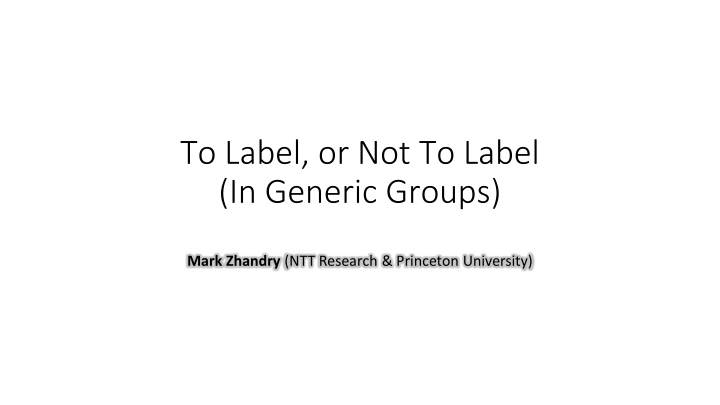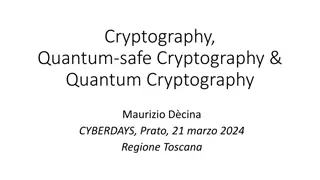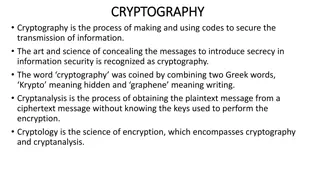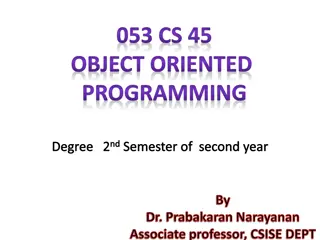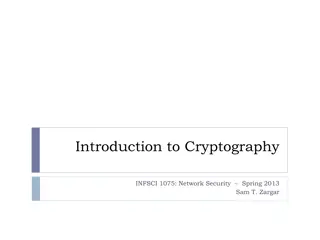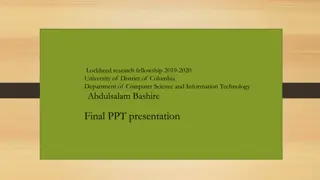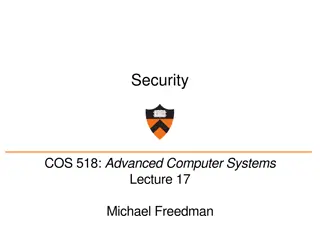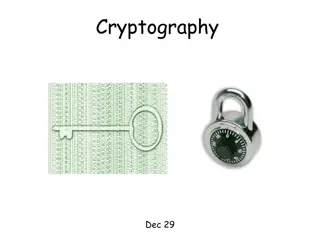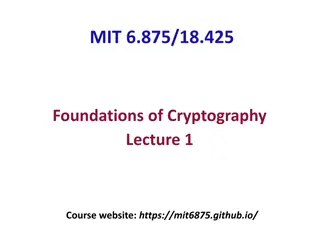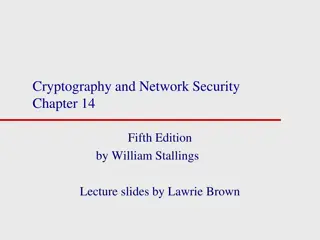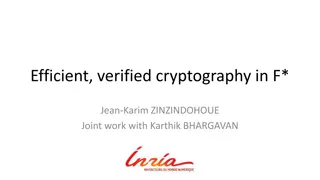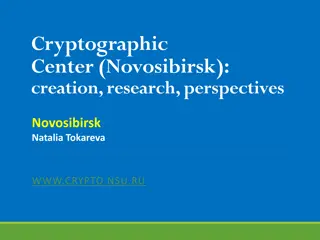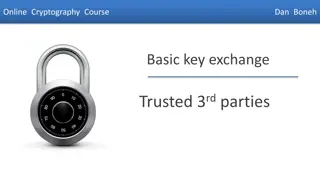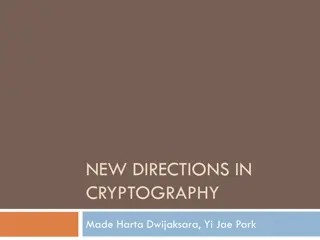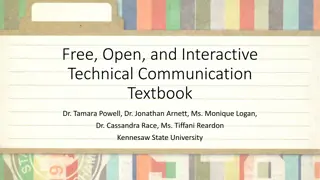The Generic Group Model: Exploring Textbook Techniques in Cryptography
This article delves into the generic group model, addressing various cryptographic techniques such as Feistel networks, signature trees, and more, showcasing their applicability across different group settings.
Download Presentation

Please find below an Image/Link to download the presentation.
The content on the website is provided AS IS for your information and personal use only. It may not be sold, licensed, or shared on other websites without obtaining consent from the author.If you encounter any issues during the download, it is possible that the publisher has removed the file from their server.
You are allowed to download the files provided on this website for personal or commercial use, subject to the condition that they are used lawfully. All files are the property of their respective owners.
The content on the website is provided AS IS for your information and personal use only. It may not be sold, licensed, or shared on other websites without obtaining consent from the author.
E N D
Presentation Transcript
To Label, or Not To Label (In Generic Groups) Mark Zhandry (NTT Research & Princeton University)
The generic group model
Shoup96: Random labels Maurer 04: Pointers Mult(Element h1, Element h2) { return new Element( h1.value * h2.value); } EqualQ(Element h1, Element h2) { return h1.value==h2.value; } = Random Injection Interpret as Oracle: No other operations on Element variables allowed Mult(L(x),L(y)) = L(x+y)
TLDR: [Shoup 96] [Maurer 04] Fails to capture many textbook generic techniques preferred
An apparent contradiction: [Jager-Schwenk 08]: In this paper we prove the equivalence of the models proposed by Shoup and Maurer Intuition: can t do anything with random label other than feed it back into oracle VS Thm [Chen-Lombardi-Ma-Quach 21]: non-cryptographic hash for Fiat-Shamir+ Thm [Do ttling-Hartmann-Hofheinz- Kiltz-Scha ge-Ursu 21]: Schnorr secure in Shoup, even with Signatures impossible in Maurer
Starting observation: textbook techniques that fail in Maurer [Blum-Micali 84] [Merkle-Damg rd 89] [Goldreich-Goldwasser- Micali 84] PRG (a,b) gahb
Starting observation: textbook techniques that fail in Maurer [Blum-Micali 84] [Merkle-Damg rd 89] [Goldreich-Goldwasser- Micali 84] Feistel Network Authenticated Enc m x gx x1
Starting observation: textbook techniques that fail in Maurer [Blum-Micali 84] [Merkle-Damg rd 89] [Goldreich-Goldwasser- Micali 84] Feistel Network Authenticated Enc m [ElGamal 85] [Schnorr 89] Signature Trees x gx x1 [Fiat-Shamir 86] or (gr,hr m)
Starting observation: textbook techniques that fail in Maurer [Blum-Micali 84] [Merkle-Damg rd 89] [Goldreich-Goldwasser- Micali 84] Feistel Network All these techniques are entirely generic and black box, independent of what group is being used. They moreover work in Shoup s model. All that is required is that there is some way to interpret group elements as strings Authenticated Enc [ElGamal 85] [Schnorr 89] Signature Trees F PRG (a,b) gahb c pk00 [Fiat-Shamir 86] or
Our Results, Part I Thm: CRHFs with unbounded domain in Maurer Thm: PRPs in Maurer Thm: rate-1 encryption in Maurer Black box separations in Maurer must be taken with grain of salt
So whats the deal with Jager-Schwenk? Historical note: Generic groups originally only used for analyzing hardness of computational problems. Use for impossibilities came later [Dodis-Haitner-Tentes 12, Cramer-Damg rd-Kiltz-Zakarias-Zottarel 12, Papakonstantinou-Rackoff-Vahlis 12]
So whats the deal with Jager-Schwenk? Thm [Jager-Schwenk 08]: Game Game Mauer Shoup Important: Only sensible if game works in both models!
Single stage Multi-stage Game Game Examples: essentially all of the basic security games Examples: deterministic encryption, leakage resilience, auxiliary input one-wayness, etc
Our Results, Part II Thm: Any cryptosystem/game in Maurer also works in Shoup of Jager-Schwenk Re-interpretation Part I and prior work already disproved converse Thm: Amongst Maurer games, Shoup security Maurer security Thm: Amongst single-stage Maurer games, Maurer security Shoup security Thm: multi-stage Maurer game secure in Maurer but not in Shoup (Also insecure in any standard-model group)
Def: Uninstantiability result = secure in generic group model + insecure in any actual group Observation: All existing single-stage generic group uninstantiability results only work in Shoup Typical technique: break scheme by finding code such that Could Maurer single-stage games avoid uninstantiability results?
Our Results, Part III Thm: single-stage Maurer game secure in Maurer but not in real world Bitwise ElGamal + one extra (contrived) bit , ,
Thm [Papakonstantinou-Rackoff- Vahlis 12]: No IBE in some generic group model Claim Shoup, but This is a Maurer-style restriction! Used in crucial step of proof to compile out group elements in secret keys
Our Results, Part IV Thm: IBE impossible in Shoup s model Adapt existing techniques, but make sure every step makes sense in Shoup
Algebraic Group Model (AGM) [Fuchsbauer-Kiltz-Loss 18], building on [Paillier-Vergnaud 05] Game (a1,a2,a3, ) s.t. h = g1a1g2a2g3a3 Non-black box access to group Often claimed to be between generic groups and standard model
Observation: AGM not fully defined by FKL Trivial uninstantiability: but cast as a string h but as a group element Game Finding representation impossible! [FKL]: Syntactically distinguish group elements from non-group elements, non-group elements must not depend on group elements What does depend mean?
Our position: AGM only applies to Maurer games [Katz-Zhang-Zhou 22]: Different interpretation
Our Results, Part V Under our interpretation: Cor: AGM incomparable to Shoup Thm: single-stage Maurer game secure in AGM but not in real world
Open question Existing games in AGM: Trivially equivalent to standard model Secure in AGM (in suitable group) iff secure in Maurer (don t ask adversary for group elements) Q: Are there any games that don t fit into these two buckets?
Summary [Shoup 96] [Maurer 04] Black box separations: Shoup preferred, Maurer may provide useful guidance Security proofs: Shoup = Maurer for single-stage games Maurer seems unsuitable for multi-stage games Thanks!
